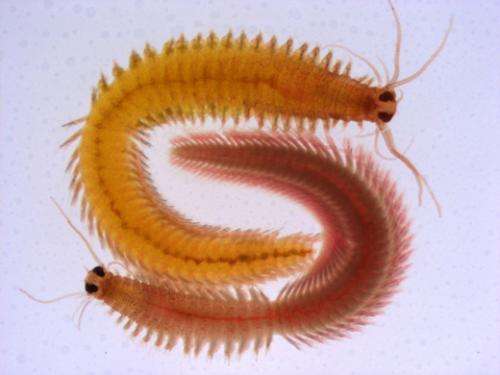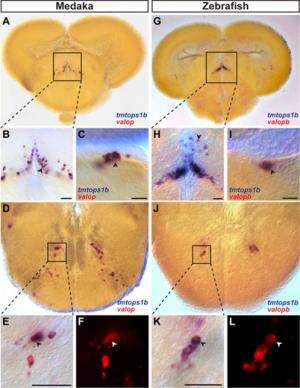Life's rhythms

While our "body clock" regulates our 24 hour daily routine, a woman's menstrual cycle follows a 30 day rhythm. Many marine animals, such as the worm Platynereis, synchronize their reproduction rhythm with the lunar cycle. A one-of-a-kind research platform at the Max F. Perutz Laboratories of the University of Vienna now investigates how such "rhythms of life" are regulated on a molecular level.
Timing is crucial for the love life of the marine bristleworm Platynereis dumerilii and the survival of that species. The reproductive cycle of these worms takes place outside of their bodies at the water surface. This means that male and female need to meet at the right time at the right place, so that eggs and sperm can come together. If their timing is bad, the eggs and sperm will dissolve in the water.
To indicate a meeting place the worms secrete pheromones, a certain type of hormones that attract the opposite sex. However, these pheromones only work over short distances, so male and female worms need to be in close proximity at the same time. Already in 1911, it was shown that the reproduction rhythm of Platynereis is synced to the phases of the moon. START-prize awardee Kristin Teßmar-Raible and her team at the Department for Microbiology, Immunology and Genetics at the Max F. Perutz Laboratories of the University of Vienna, investigate how this syncing process works on a molecule level.
Worms and the moon
Platynereis is able to detect the blue, green and yellow light of the full-moon up to ten meters below the water surface and react accordingly. The neurobiologist is looking for the light-receptive cells that detect the lunar light. Using molecular genetics, Teßmar-Raible and her husband Florian Raible (who also works at the Department for Microbiology, Immunology and Genetics) have identified four potential moonlight receptors. "A real technical breakthrough", says Kristin Teßmar-Raible excitedly about the results of the study, which were published in "PNAS" recently. "This allows us to investigate which cell and gene, respectively, are responsible for the detection of the lunar light in Platynereis."
However, Platynereis is not the only species that synchronizes its reproductive rhythm to the lunar cycle. This phenomenon is known in other species from corals to vertebrates as well. Therefore, the new research platform "Marine rhythms of life" which is headed by Kristin Teßmar-Raible also investigates the marine midge Clunio marinus. The difference is that compared to Platynereis, Clunio only "recently", at least from an evolutionary perspective, developed the "lunar clock": around 20 000 years ago when they returned from the land to the sea.

The researches – in particular Tobias Kaiser, Postdoc of the VIPS-program headed by Renée Schroeder – have sequenced the genome of the marine midge and have identified those areas that are linked to the regulation of the monthly and daily clocks. "Now we have to clarify, which genes regulate the lunar clock and which ones regulate the sun or daily clock", says Kristin Teßmar-Raible. This work is supported by Arndt von Haesseler at the Center for Integrative Bioinformatics Vienna (CIBIV, at the Max F. Perutz Laboratories or the University of Vienna and the Medical University of Vienna).
From Clunio to Drosphila
The neurobiologist and electrophysiologist Thomas Hummel from the Faculty of Life Sciences of the University of Vienna is also involved in the research platform. He is an expert for research of the fruit-fly Drosophila. "The work on Clunio is pioneering, so there are no established techniques regarding the research of this midge. This means that all techniques to genetically characterize this species need to be developed and validated, which is very time consuming", says the head of the research platform Kristin Teßmar-Raible. "This is why Thomas Hummel is looking into the candidate genes we identified in Clunio in the well established model organism Drosophila."
In the long run, together with Thomas Hummel, the researchers also want to find out how the brains of the marine bristleworms process the detected lunar light. "Essentially we want to know, how the worms know which one is the sun light that synchronizes their daily 24 hour rhythms, and which one is the lunar light that regulates their monthly rhythms", says Teßmar-Raible.
Light-susceptible hormones
And then there are the hormones… Melatonin is known to be crucial for the 24 hour clock, also in humans. ERC-awardee Florian Raible and his research team at the Max F. Perutz Laboratories have shown that the enzymes that synthesize this key hormone exist in Platynereis, and seem to be strongly connected to the monthly lunar rhythm. "Interestingly we find melatonin in close proximity to the photoreceptors that we suspect to be the lunar light receptors", explains Krsitin Teßmar-Raible. What the hormone is doing there exactly, is investigated by Florian Raible in collaboration with Christopher Gerner from the Institute of Analytical Chemistry of the University of Vienna using mass spectrometry.
Kristin Teßmar-Raible is excited that her research group is on track "to present new concepts of how various animal species detect moon and sun light". Just recently, her team published a study in the scientific journal "PLOS Biology", explaining the influence of light on inter-neurons – information processing cells– in the brain of fish.
Kristin Teßmar-Raible is particularly excited by the inter-disciplinary aspect of the research platform: "There is a wide variety of marine research at the University, covering many different disciplines. The research platform is a great way to facilitate close collaborations between the various groups." Another aim of the research platform is to help young academics to prosper: "Marine rhythms of life" employs two international PhD students and one Postdoc.
The name "Marine rhythms of life" was developed during a network meeting of the multi-disciplinary EU-project "EuroMarine", which combines research across the fields of biodiversity, genome research and ecosystem modeling. Kristin Teßmar-Raible is a member of one of the working groups that develops recommendations for the future development of the marine part of the EU program Horizon 2020, and by doing so is shaping the future of EU marine research: "To research the rhythms that affect the life of all marine species was made one of the major points of the recommendation letter".
Journal information: Proceedings of the National Academy of Sciences , PLoS Biology
Provided by University of Vienna


















